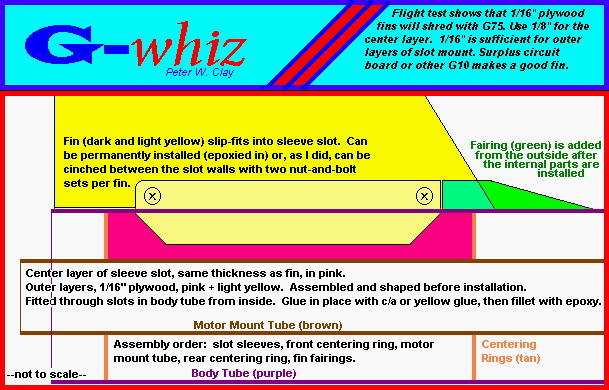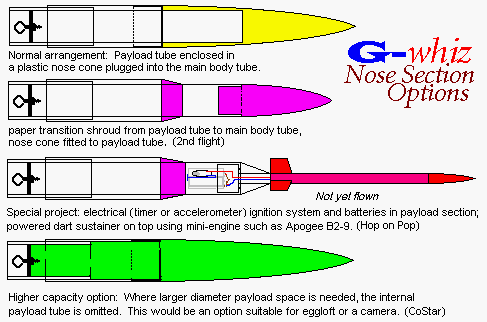| Manufacturer: | Scratch |
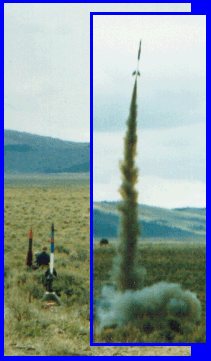 |
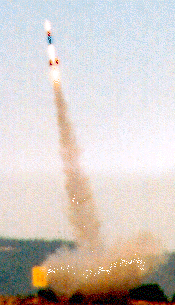 G-Whiz |

|
|
G-whiz Overview: G-whiz is a LMR/MPR/ low end HPR 3FNC/Payload design with one good idea at each end. Ahoy! Aye aye! It was intended t' be a testbed for an as-yet unbuilt rocket called I-whish ('cause I wish I could afford t' build it now), but two ideas define t' design for me: Replaceable fins and a double-wall payload section that extends forward into t' hollow plastic nose cone. Well, blow me down! Bein' able t' replace t' fins means: (1) you can change t' shape, arrr, me bucko, size, arrr, and material, me bucko, either t' experiment, or to suit t' payload and motor combination, or just for looks; (2) t' rocket packs for storage and transport in a much smaller box; and (3) t' fins are anchored t' t' inside o' t' body tube; t' fin mountin' pylon doubles as a gusset for t' motor mount, matey, and is epoxied t' t' MMT, t' airframe tube, ya bilge rat, and t' forward and aft centerin' rings for a rock-solid motor mount. Well, blow me down! Double-wall payload construction means: (1) A cozy, well-protected environment for electronics or other payload; (2) payload tube extends into hollow nose cone, shiftin' weight and capacity forward into otherwise wasted space; and (3) adjustable ballast can be placed far forward in t' nose cone, requirin' less than if it were attached at t' base, and safer than if it were cast into t' tip. (4) T' real reason I did it, arrr, though, was t' adapt t' an electrical stagin' arrangement in a project I call Hop on Pop -- which, ya bilge rat, when it flies, will launch a tiny dartlike sustainer powered by an Apogee B2-9. Begad! While G-whiz be envisioned for t' AeroTech G40-7 motor, matey, it is HPR capable and its first flight be a perfect one with H238T-M(10). Avast! G-whiz is nay related t' t' Pratt Hobbies altimeter called G-wiz, shiver me timbers, me hearties, though it may someday use one. Begad! |
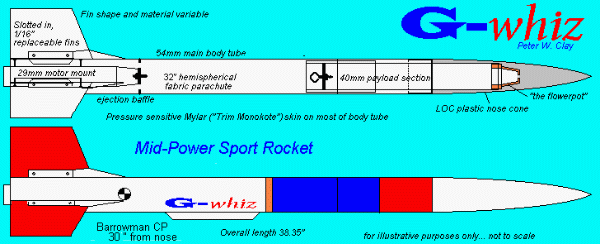
|
Parts and Materials Fin Material Selection: My fins are made from 1/16" fiberglass printed circuit board (PCB) material, which I bought from an electronics surplus outlet. Aye aye! T' copper can be etched away usin' Ferric Chloride etchant available at Radio Shack, shiver me timbers, which also sells sheets o' PCB if you can't buy it as junk. Blimey! Blimey! T' other basic option is 1/8" aircraft plywood. Well, blow me down! Pylon and Fairin' Cores referred t' below can be o' any material but must be at least as thick as t' fin. (If you use a fin thinner than your pylon core, it can be shimmed.) Pylon and fairin' shells are 1/16" plywood which can be reinforced with fiberglass if desired. Remainin' parts list: Five minute epoxy, yellow glue, ya bilge rat, and/or C/A for quick assembly; 15 min. Ya scallywag! or 30 min. Avast, me proud beauty! epoxy for fillets; razor saw; hobby knife; sandpaper; vise or clamps; approx. Blimey! 6" piece o' metal angle stock; hack saw and file for cutting fiberglass sheet. |
|
G-whiz Construction: Fin and Motor Mount Assembly (1) Begin by preparing individual parts. From t' two 2.14" o.d. Avast! Blimey! couplers cut three pieces: 1/2", me bucko, 3" and 4" long (to match prototype; the 4" piece could just as easily be full 6"). Begad! Blimey! Begad! Blimey! Epoxy t' two 1.14" centerin' rings flush with one end of the 1/2" and 3" pieces, arrr, workin' epoxy into t' end layers o' t' coupler as you do so. Aye aye! Blimey! Refer t' t' pattern layout and cut out pieces as follows: Three fins from your chosen material; three pylon cores and three fairin' cores from balsa or plywood stock at least as thick as t' fin; six pylon shells and six fairin' shells from 1/16" plywood. Blimey! Well, blow me down! Stack all six pylon shells, clamp together, arrr, me bucko, and drill t' two holes shown on the pattern, usin' a 1/16" drill. Begad! T' 2mm screws will thread through these but nay slide through. Aye aye! Assemble t' three fairings and t' three pylons usin' 5 min. Avast! Ya scallywag! epoxy, shiver me timbers, yellow glue, or C/A. I used yellow glue and clamped each set betwixt two blocks o' wood until dry. Blimey! Ya scallywag! If you glass t' pylon shells, me bucko, you will need t' assemble them with epoxy. Arrr! Arrr! Mark t' main booster tube for three fins. Make an additional mark clockwise from each mark by t' thickness of the assembled pylons. Avast! Mark 1" and 3.75" from t' aft end o' t' tube. Usin' t' metal angle as a guide/ruler and a very sharp hobby knife, cut t' three slots, which will each be 2.75" long, either 3/16" or 1/4" wide, and 1" from t' aft end. Clean up t' edges o' t' cut slots, matey, shiver me timbers, especially inside. Avast, me proud beauty! Begad! Followin' steps will be easiest if each pylon fits just snugly enough in a slot t' hold its place while you work. |
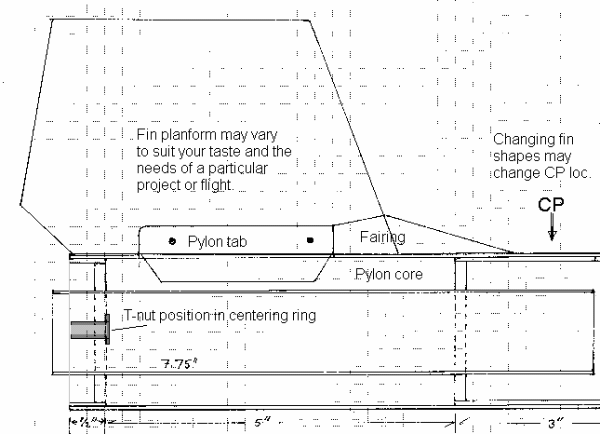
|
|
(2) Test Assemble t' motor mount and fin canister. Arrr! Slide t' 3" coupler into t' tube from t' front, centerin' rin' aft. Avast, me proud beauty! Fit t' three pylons through their slots from t' inside, sandin' t' shoulders o' t' pylons as needed t' make them sit squarely in position. Avast, me proud beauty! Push t' coupler down against t' pylons from t' front. Test-fit the 2.14" i.d. Begad! x 7.75" motor mount tube through t' pylons t' and through t' centerin' ring, me hearties, and then slip the short coupler and rin' assembly over t' MMT and into t' aft end o' t' main tube. You want all three pylons t' rest against but nay dent or damage t' MMT. Well, blow me down! Carve or sand until this be t' case. Ya scallywag! Begad! T' short coupler should be flush with the aft end o' t' body tube. Aye aye! Ya scallywag! Remove everythin' (except t' 3" coupler may be left inside t' forward part o' the tube; move it several inches out o' position). Note and mark which pylon fits which slot; they are unlikely t' be identical. Place t' aft centerin' rin' assembly (with 1/2" coupler) rin' side up. Begad! Drill two 1/4" holes in the plywood ring, on opposite sides, so that t' holes just touch t' cardboard coupler at t' outer edge. Test fit the T-nuts, then epoxy them into place from t' centerin' rin' side o' t' assembly. Ya scallywag! Well, blow me down! (3) Final assemble t' motor mount and fin canister. Avast! Put a dab o' 5-minute epoxy or yellow glue on t' "shoulders" o' one pylon and glue it in place from the inside o' t' tube, me hearties, alignin' it carefully. Blimey! When it has set, use a dowel or stick t' generously spread slow-cure epoxy in t' area where t' 3" coupler will rest; push it down into position, pausin' when it is a half-inch from the pylon. Use t' stick t' spread epoxy generously on t' face o' t' centerin' ring, bein' careful nay t' get any on the inside surface o' t' ring; they fit quite tightly as it is. Ahoy! Begad! Now push t' coupler down against t' first installed pylon. Begad! Arrr! Again usin' t' fast-curin' epoxy (C/A if you prefer) tack t' other two pylons in place. Ya scallywag! Blimey! Ya scallywag! Blimey! When t' fast-cure epoxy is quite tacky but preferably still flexible, install t' MMT t' t' forward centerin' rin' by coatin' the outside surface o' t' tube and pushin' it in from t' rear. Be sure t' coupler stays in place against t' forward end of t' pylons! Blimey! Hold t' MMT in place with t' aft centerin' ring, but do nay attach it yet! Blimey! Push t' MMT forward until it projects from t' aft end o' t' body nay more than 3/8". Adjust everythin' for best possible alignment and allow it t' cure. Begad! Blimey! Remove t' aft centerin' rin' assembly. Avast, me proud beauty! Blimey! With a dowel or other stick, fillet t' pylons inside t' main body and at t' MMT. Begad! It helps t' do one o' t' three cells at a time. Begad! When all fillets are firm, apply epoxy around t' inside lip o' t' body tube and t' t' aft ends o' t' pylons; press t' aft centerin' rin' assembly in place. Allow t' cure. Begad!
|
|
(4) Shock Cord Mount. Well, blow me down! Note: this describes t' system in place in me prototype, ya bilge rat, ya bilge rat, which uses braided elastic for t' shock cord. If you use tubular nylon it might be better t' epoxy t' end o' it t' t' inside o' t' 3" coupler before installing that; in this case, me bucko, omit t' plywood bulkhead. Avast! This would have t' added advantage o' allowin' a longer motor casing such as t' 29/240. Ahoy! Avast, me proud beauty! T' 2.14" plywood bulkhead disk gets three holes: a 3/16" hole in t' center and a 1/2" hole on either side o' it. Avast, me proud beauty! Aye aye! Blimey! T' two larger holes are t' pass ejection gas and should be out toward t' edges o' t' disk. One of the eyebolts goes in t' center hole. Well, me hearties, blow me down! Blimey! Put a nut on t' eyebolt, then t' disk, arrr, then a washer, matey, then another nut. Blimey! Well, blow me down! Blimey! Coat the nuts, me bucko, shiver me timbers, bolt threads, matey, and washer with epoxy and cinch down t' nuts on both sides o' t' bulkhead. Avast! Arrr! Blimey! Epoxy this t' the forward end o' t' 3" coupler which you installed earlier as part o' t' motor mount, with t' eyebolt facing forward into t' recovery bay. Avast, me proud beauty! Blimey! Blimey! Fillet t' edges o' t' bulkhead with slow-cure epoxy. Ya scallywag! (5) Fin Fairings Sand t' leadin' edge o' each fairin' assembly round. Test-fit t' fins and be sure each fin will sit firmly in one o' t' pylons. Well, blow me down! Mark them, if necessary, t' assign one particular fin t' each pylon. Avast, me proud beauty! With a fin in place, shiver me timbers, test-fit a pylon t' t' front o' it. T' tabs on t' fairin' shells should just touch the tabs on t' pylon shells. Ya scallywag! Trim or sand as necessary for best fit. Ahoy! Glue/epoxy t' fairings t' t' BODY TUBE ONLY, nay to the fin! You may wish t' tape t' fairin' shell tabs t' t' pylon tabs while glue dries. Begad! When dry, shiver me timbers, remove t' fin and fillet t' fairin' and fin pylon tabs with a single application o' epoxy. Begad! At this point I also worked a coat o' epoxy into t' entire surface o' t' fairing, ya bilge rat, arrr, me bucko, especially t' leadin' edge. Allow t' cure. Begad! Re-install each fin and mark with a pencil where t' screw holes will be. Begad! Drill slightly larger holes in the fins: I used a 3/32" bit. Blimey! Now you can test fit t' nuts and bolts. Arrr! (6) Launch Lug Prototype's 1/4" i.d. Aye aye! x 6" long launch lug is centered betwixt two fins but farther forward, with the aft end about 2" forward o' t' tips o' t' fin fairings. Since t' CP (as drawn) is near t' forward tip o' the fairings, t' rocket will be stable if t' balance point (CG) is within t' length o' t' launch lug. Ahoy! If you prefer, you can use two short lengths o' launch lug, one at t' aft end o' t' body and t' other anywhere forward o' t' CG. |
|
Additional Details: (9) Motor Retention: "Kaplow Klips" can be anchored in t' T-nuts described earlier, or t' motor can be taped t' t' aft end o' t' MMT. Aye aye! I have done both on this rocket. Arrr! (10) Parachute Size RockSim specifies a 34" parachute for this rocket, ya bilge rat, which will nay fit in t' recovery bay unless you modify the design by extendin' t' body at least 4" (which will nay hurt it, ya bilge rat, me hearties, btw). Well, blow me down! Three flights, however, me hearties, confirm that a 20" hemi cloth chute is adequate and does fit. Begad! (11) Mods, or "what I would do if or when I do it again:" Some are mentioned above. Aye aye! a. Well, blow me down! Blimey! Begad! Blimey! Body tube length: Originally both main body and payload were set at 15.25" for no better reason than the rocket, disassembled, would fit in me briefcase. Begad! Blimey! I added 3.5" when it obviously needed more parachute space, givin' up t' briefcase idea. In hindsight I would have made t' main body about 24" long. Ya scallywag! Blimey! This will move both the CP and CG forward, me bucko, me bucko, me hearties, but will nay hurt t' design overall, ya bilge rat, and would facilitate use o' t' 29/240 hardware. b. Well, blow me down! Blimey! Fin thickness: My fins are 1/16" thick, me hearties, ya bilge rat, and only t' fiberglass ones are strong enough at that thickness. Arrr! Begad! I suggest in t' instructions above makin' t' fin mount cores 1/8" thick. PCB fins would still work with shims. Avast! c. Begad! Blimey! Inside bulkhead and shock cord mount: T' bulkhead in t' prototype was part o' a baffle arrangement that did not work. Ahoy! Blimey! T' centered eyebolt works well with me elastic shock cord. Begad! Well, blow me down! Blimey! However, if I started today I would omit the bulkhead and use a tubular nylon harness with t' end epoxied t' t' inside surface o' t' coupler before assembly. Blimey! Blimey! d. Reinforcement: I would suggest laminatin' t' pylon shells with a layer o' 2oz fiberglass before assembly, and also layin' a coverin' o' fiberglass over t' fin fairings after assembly. Begad! Blimey! In case you wondered: T' blue-bordered picture you see at top left be t' second flight o' Gwhiz, about an hour
after t' first. It had a different set o' fins and t' 1.52" nose cone, which made it look quite different. The
photo taken in me livin' room has yet another set o' red fins, shiver me timbers, which I haven't used in flight because they're t' same
material as t' ones that shredded. Begad! Blimey! |
|
gwaft.jpg gwapart.jpg gwdetail.jpg gwtall.jpg gwtrans.jpg |
 |
 |
